Fall 2012 A publication of the Wildlife Division—Getting Texans Involved
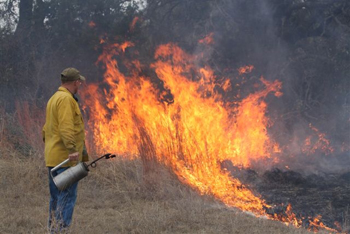 Fire, a Change in Prescription
Fire, a Change in Prescription
By Ryan Reitz
These reactions and many others exist in our environment. We have become dependent upon many of them to contribute to our success. The same can be said for fire, a chemical reaction that exists when the appropriate components of fuel, heat and oxygen are present. I think we all can agree, not only does fire contribute to heat in a camp stove, grill or oven but the potential for fire is present in any landscape with the appropriate resources, and fire has played significant evolutionary roles in the development of plants and animals.
As humans we quantify associations, relationships and change over time to communicate. Our first descriptions of the landscape here in central Texas vary somewhat. Tall grass prairies, live oak savannahs, burned prairie or dense cedar brush thickets are depicted in historical accounts. Although describing an ecosystem is difficult we have done so in many ways throughout our history. For example, grass belly high on a cow, abundant game, available firewood or sight distance are measurements that present the reader with a mental image of the historical landscape.
When describing an ecological system or ecosystem, one thing is certain, change. Change is constantly occurring, driven by soils, rainfall and disturbances. Of the disturbances imposed on the landscape, the most dramatic have been from humans. European settlement accounts in the mid 1800's depict not only the landscape but a way of life. Cattle, sheep, goats, horses, donkeys, mules and fencing increased sharply with settlement practices. Fire on the landscape, once broad, extensive and frequent was considered disastrous thus controlled. The landscape at that time was a product of very powerful forces and a shift away from a fire dominated landscape began to produce a very different product quickly. Heavy continuous grazing brought on significant changes in the historical disturbances governing the plants and animals of the landscape, yielding a much different product than described in historical accounts. We were suddenly faced with a problem and we fought the changing landscape with expensive mechanical methods to reduce an intense assault of plants selected by our actions - brush.
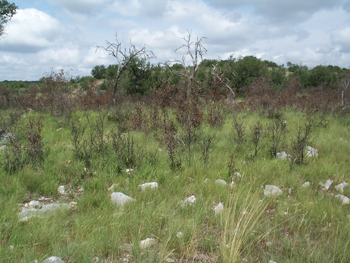
By the 1970's the components of fire, relationships to weather and the application of fire came under question. By understanding the central components of fire (fuel, heat and oxygen) and its behavior, fire began to demonstrate a tameness with perceived benefit. Humidity in the air, moisture in fuels and wind speed were identified as factors directly related to the intensity of fire. Prescribing fire was becoming more common.
Although the goals of fire are different today, Native Americans demonstrated the first use of "fire prescriptions". Whether to flush out game, attract game or restore a landscape, the common goal then and now is to use fire with a perceived benefit. Burning under a set of predetermined conditions to achieve a goal is a prescribed burn.
In wildlife management, goals revolve around habitat and the primary contributor to habitat is plants. Plants have a unique way of organizing themselves: forbs (annual plants), herbaceous perennials (mostly grasses) and browse or woody plants. Dormant grasses are our main fuel for fire on the landscape, gaining and losing moisture in relation to the humidity in the air. Dormant grass is usually 1 hour behind the relative humidity in the air and is subject to change as weather changes while larger fuels retain moisture for much longer periods. In other words, moisture is obtained and lost at slower rates as the fuel size increases, which affects the behavior of fire. Therefore, selection of the time of year, grazing practices and climatic conditions (drought, etc.) determine the behavior of fire, results and product from a prescription. For example: Burning in January under a set of environmental conditions of 30 percent humidity, wind speeds less than 10 mph and dormant grass at greater than 1200 lbs per acre will have an expectant yield of 80 percent kill on ashe juniper less than 4 feet tall . Furthermore, large trees (remember the moisture factor) will not be harmed. However, prescriptions can easily change to consume smaller woody plants. For example: A prescription within 20-25 percent humidity and wind speeds of 5 mph can effectively burn through shin oak and live oak mottes. Fire prescriptions can range from simply reducing fuel loads to prevent devastating wildfires to fertilizing range sites to increase plant vigor from ash.
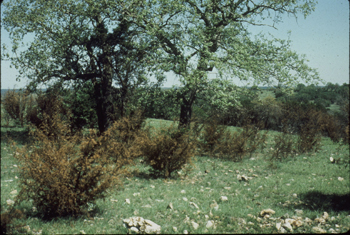
These are a few of many examples of fire prescriptions. Regardless of the prescription, the bottom line is that plants and plant communities have dealt with and adapted to fire and that this manipulation by fire causes change. What type of change fits into your management goals?
We have come full circle here, it really is easy to forget just how powerful and frequent fires were on the landscape prior to European settlement. Although we may have enjoyed the outcome or product of pre-settlement prescriptions, fires are surely something we should respect. Fire is a tool and just like any tool it can be used improperly. Effective training and experience is necessary for the successful prescription of fire. By understanding environmental conditions and setting goals, fire can be a very productive tool in your wildlife management toolbox. To learn more about what others are doing with prescribed fire visit: http://www.tpwd.state.tx.us/landwater/land/technical_guidance/burn/.
Please use responsibly!
Ryan is a wildlife biologist at the Kerr Wildlife Management Area.
Historical Role of Fire
It's Effects in Shaping our Plant Communities
By Ricky Linex
That fire has touched every acre during every season of the year is a profound statement and shows the major influence fire has exerted in shaping our land. Fire is recognized as a natural component in the ecological development of many plant communities and most importantly that of the grasslands in the Great Plains of which Texas forms the southern boundary. No range with its associated plant community has developed without being influenced by fire.
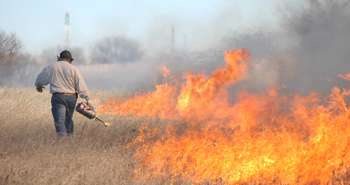
What separates the grasslands from forested areas? There are many components which help shape the land including climate, soil, plants, animals, microbes, fire and the interaction of these components over time. Climate and especially rainfall defines the boundary where dense trees begin to thin and grasses begin to dominate. Fire or the lack of fire can influence the fluctuations of woody vegetation into these grassland areas. Some regions of Texas have always had moderate to thick stands of woody cover, including the Piney Woods, Cross Timbers, Edwards Plateau and South Texas Plains. Grassland dominated areas historically included the Post Oak Savannah, Blackland Prairie, Gulf Prairies and Marshes, Rolling Plains, High Plains and lower elevations of the Trans Pecos region. Much of the "native grasslands" in these regions no longer resembles its historical description due to combinations of brush encroachment, long-term heavy grazing, repeated droughts and suppression of fire.
Wildfires traditionally happened during drought years which were preceded by one to three years of above average precipitation which produced heavy fuel loads of fine stem grasses. In pre-settlement Texas when a wildfire started on the prairie, likely by lightning, there was little to slow the spread of the flames and these fires could burn thousands of acres over many days. These fires would continue until they encountered a topographic break, a wide river, a recently burned over area or until rain from a thunderstorm could extinguish the flames. Native Americans witnessed these early wild fires and saw the benefit of using fire to freshen the prairie which would attract American bison to the tender, green vegetation. Fire was also used by Native Americans as an offensive and defensive weapon when fighting with other tribes. Whatever the cause, fire has been a frequent companion to the grasslands and forest, especially during droughts. Since the grasslands did not have fire scarred trees to use in estimating fire frequency the most reliable sources are historical documents by early military excursions across the area. Based on these documents, Henry A. Wright proposed in the late 1970's that level to rolling topography of prairie grasslands would have had fire across the area every five to ten years while in rough topography, such as areas of the Rolling Plains and the Edwards Plateau, fire frequency may have been 20 to 30 years.
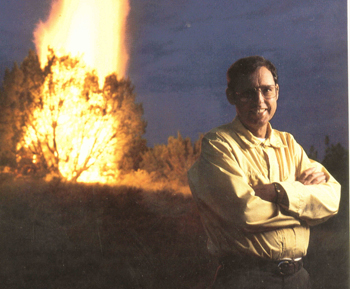
During the early to mid 1800's the frequency of wildfires caused by lightning and Native Americans was surpassed by the carelessness of early explorers, cattle drives and settlers. During this period wildfires would continue to burn large areas. During the late 1800's as homesteaders and settlers laid claim to the lands of Texas, wildfire was a threat to the survival of all that lived on the land. Fire has no respect for man's improvements to the land as crops, dwellings, equipment and fences could be wiped out in just a day as flames raced across the land. At the first call for help or upon seeing smoke on the horizon, settlers would stop whatever they were doing and hurry to help fight the spread of wildfires. These early attempts at control often involved only the use of wet tow sacks or saddle blankets to slow the lateral spread of the fires. Drastic times call for drastic measures with a historical reference at snuffing the advance of a flame front, involved the use of a steer which was killed, skinned from belly to back on one side and ropes tied to a front and rear leg. Two mounted cowboys then pulled the steer carcass, skinned side down with the loose hide dragging, over the flame front with one cowboy riding in the area already burned and the other riding in the un-burned grass. The interspersion of newly cultivated land also helped slow the flames by removing the continuous fuel needed to carry the fire.
Eventually when sufficient numbers of settlers, farmers and ranchers came to Texas the widespread burning by wildfires was minimized by primitive fire fighting methods, grazing by livestock which removed excess vegetation and interspersion of cropland, roads and communities. In the early 1900's Smokey the Bear became a symbol that "only you can help prevent forest fires" which served to further remove the use of fire, wild or planned, from our grasslands and forests. The combination of fire suppression, continued heavy grazing by high numbers of livestock, severe droughts during 1917-19, again in the 1930's and the 1950's, allowed the introduction and spread of many brush species into formerly grassland areas. During the early 1900's the use of fire was a forgotten tool and was not practiced on Texas rangelands.
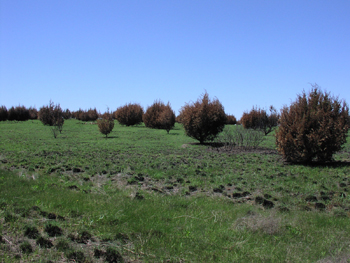
The re-introduction of fire, in the form of prescribed fire or burning following a prescription using a prescribed combination of temperature, wind, humidity and quantity of fine fuels, is usually attributed to the early work of Dr. Henry Wright. Arriving at Texas Tech University in 1967, Dr. Wright immediately went to work using fire to develop the prescriptions for safely burning different types of fuels under different weather conditions. There are many range professionals who promoted and practiced the rebirth of prescribed burning as a tool to manipulate rangeland vegetation and if I miss an individual, I apologize for the oversight. Early fire bosses in addition to Dr. Wright include Dr. Larry White, Dr. Wayne Hanselka, Dr. Charles Scifres, D. Lynn Drawe, Bill Armstrong, Donnie Harmel, Dr. Butch Taylor, Jake Landers, Dr. Carlton Britton, Rhett Johnson, Stan Reinke, Steve Nelle, and retired NRCS conservationists Alan Heirman, Albany, TX who has developed and participated in 396 prescribed burns. Mr. Heirman was also the third Master's degree student of Dr. Henry Wright at Texas Tech University.
Since 1981 NRCS has assisted landowners in planning and implementing prescribed burns on rangeland, pastureland, marsh and forest. Contact the NRCS in your county for assistance.
References:
Wright, Henry A. and Arthur W. Bailey. 1979. The Role and Use of Fire in Grasslands, A State of the Art Review. Northern Forest Fire Laboratory, Missoula, Montana.
Welch, Tommy G., Editor. 1982. Prescribed Range Burning in Central Texas. Texas Agricultural Extension Service. College Station, Texas.
Haley, J. Evetts. 1929. Grass Fires of the Southern Plains. West Texas Historical Association Year Book, Vol.5 June, 1929. Lubbock, Texas.
Pyne, Stephen J. 1997. America's Fires, Management on Wildlands and Forests. Forest History Society. Durham, North Carolina.
Ricky Linex is a Zone Wildlife Biologist with the Natural Resources Conservation Service in Weatherford, Texas.
After the Fire
By Kelly Bender
Immediately following the fire, I could only concentrate on the health of my family and the incredible process and activity that follows such a disaster. But as the smoke cleared and we began to heal, the biologist in me began to re-emerge and I was able to listen to the wisdom of the land as it, too, healed. I'm happy to share some of the realizations and thoughts I've had about this land that I still love:
Fire isn't uniform.
The first time I drove through the burned area after the Bastrop Complex Fire, I thought "It's all gone." I was devastated that it looked like the entire burn scar was completely and thoroughly destroyed. But as I trained my eye to look more closely, I saw that while some areas burned very hot and nothing but bare mineral soil, ash, and some burned-up trunks remained, other areas had a few scattered live trees. Along creeks and other areas that held water, I saw that most of the trees survived, but the brush and leaf litter was reduced. Wildlife biologists describe this non-uniform pattern of fire as a "mosaic," and it is this unevenness that helps create the different types of habitat and plant communities that are required for different wildlife species.
Prescribed fire works.
In nature, fire moves through an area every 3 to 10 years. Most often ignited by lightening, these fires often help strengthen the habitat; fire opens up a forest canopy and allows seeds and saplings to take advantage of sunlight and regenerate, replenishes the soil with valuable nutrients, and clears out thick underbrush. Fire is a natural part of the ecosystem and is beneficial for the habitat of many species of wildlife. In addition to being good for the habitat, periodic fires reduce the "fuel load," or available burnable vegetation, and controlled burns have been used to reduce the severity of future fires. For years before the devastating wild fires, Texas Parks and Wildlife has been planning and conducting very well-controlled management of the Bastrop State Park forests with prescribed fire. Areas in the park that had previously been burned in a controlled setting as part of the prescribed burn regime experienced a much less intense fire during the Bastrop Complex fire. Those areas appear to have more trees that survived and even more seeds that survived in the ground to help jump-start the regeneration process. Prescribed fire works.
Firewise landscaping works, sometimes
We know that different plants react differently in the presence of fire. Some plants have leaves rich with volatile oils and flame up almost explosively. Other plants seem to allow fire to move through quickly, but never generate enough heat to transfer the fire to other surfaces. And some plants with lots of water stored in their leaves almost appear to douse out fires. In the devastatingly intense fires in Bastrop, the effectiveness of Firewise landscaping to prevent home loss was mixed. However, it is always wise to consider the volatility of plants we use, especially those plants that are very near and under eaves of homes. This website (http://www.fire.sref.info) is informative to folks who want to evaluate landscape plants' volatility and wildlife use. In mild to moderate fires, having low-volatility plants and maintaining them according to Firewise principles could save your home.
Take pictures - lots of pictures.
Many insurance companies recommend taking pictures of everything in your home, including drawer contents, since listing out every single item in the home is often a necessary part of the insurance claim process. However, pictures of your home - inside and out - can be a valuable emotional asset as well. After the fire, I searched for pictures of my gardens and home exterior. Every single picture I found provided a little bit of comfort that what I had lost was not entirely gone. It also gave me hope for what the land could become again. I used those pictures when designing my new gardens to help remind me what I loved about my old place, and they helped me bring the best of what I had into our new home Wildscape.
The community of Bastrop continues to rebuild and grow in the year following the Bastrop Complex Fires. We have been very fortunate to receive material, financial, and emotional support of our friends, neighbors, and even strangers throughout the world, and we have received grants and donations that will even help us plant millions of native tree saplings in our parks and private lands so that one day we will have our rich jewel of a forest back again. I hope that the wisdom that we are continuing to gain will help us steward a more vibrant, healthful, and beautiful habitat than we could ever imagine. And I hope you come visit us again soon.
Kelly is the Urban Biologist for the capital area working out of Bastrop.
The Oasis Pipeline Fire: Recovery Through Partnerships
Scott Richardson - South Llano Watershed Alliance
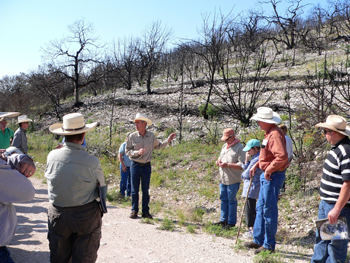
Thanks to a change in wind and the efforts of fire fighters, the head of the fire slowed and was somewhat contained on the second day. However, a shifting north wind turned the fire's southern boundary into a southward moving head fire, reaching the banks of the South Llano River and even jumping it in a few places. Luckily this advance was contained by the end of the day. Then on the third day, another strong south wind began to push the northern boundary north toward I-10. After moving in three directions over a four day period the fire was finally contained. It left nearly 9,000 acres scorched, with 1,500 of those acres being on steep slopes.
A year before the wildfire, the Texas Parks and Wildlife Department had begun a partnership with the South Llano Watershed Alliance, a citizen's group organized in January 2009. TPWD had chosen to implement the Guadalupe Bass Restoration Initiative (an effort to address the conservation of the state fish of Texas) on the South and North Llano rivers partially because of the existence of the SLWA, which represented the stakeholders of the two watersheds.
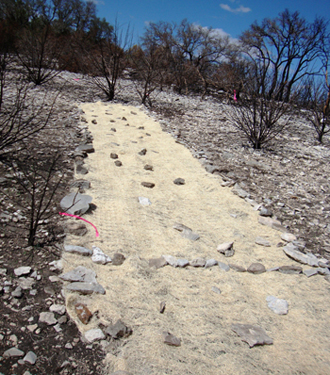
Shortly after the smoke had settled from the Oasis Fire, TPWD personnel and SLWA members began to realize the threat those 9,000 acres of scorched land posed to the habitat of the Guadalupe bass as well as the overall health of the watershed. Huge swaths of vegetation had been scorched off of the landscape, and large deposits of ash and soil lay unanchored and ready to wash into the rivers and creeks of the watershed with the next rain, potentially smothering aquatic habitats and causing the loss of valuable topsoil. The question was what should be done?
To answer this question TPWD invited representatives from various state agencies and private consultants to a meeting held on July 27, two months after the fire. Approximately 30 experts met at the Texas Tech University Llano River Field Station at Junction and spent the morning touring the destruction caused by the wildfire. Very little evidence of viable seeds or roots was found within what looked like a sterilized environment, void of any vegetation. The group spent the afternoon back at Field Station discussing what had been observed and trying to come up with solutions to mitigate fire impacts to the land and to speed recovery. There was a consensus that no precedent existed for the wildfires of 2011 in Texas, that the emphasis should be to do no harm, and that there was a critical need to get vegetation back on the land as soon as possible, especially on the steep slopes.
Steve Nelle, a biologist with the Natural Resources Conservation Service, suggested enlisting impacted landowners as part of an experiment in recovery by providing them with a specifically formulated seed mix for scorched land, having them seed small plots, and then observing and recording the results. To implement such a plan, an informational workshop would be held for impacted landowners. At that time they would be given enough seed mix to create their own experimental plots, and would also learn simple practices to reduce erosion, prevent deer browsing on seedling re-growth, and other techniques to enhance revegetation. TPWD offered to provide the funding if the SLWA would facilitate and coordinate the workshop.
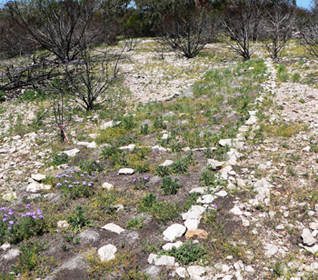
As the agency and private experts began to work together to formulate a scorched land seed mix, SLWA and TPWD began to coordinate with other partners and set a date of November 12th for a workshop at the Llano River Field Station. The other partners involved would include the NRCS, Texas Forest Service, Llano River Field Station TTU at Junction, Native American Seed, and the Upper Llanos Soil and Water Conservation District. The workshop would consist of a morning indoor session where experts representing each of the partners would cover specific topics related to the recovery of the scorched land. The afternoon session would consist of a field trip to representative sites of the Oasis Fire where demonstrations for erosion control, exclosures, and seedlings had been put in place. At the end of the day all participants would be given a pound of the scorched land seed mix for their experimental plots.

Over 70 impacted and interested landowners attended the November 12th workshop learning best management practices (as well as what not to do), and also how they could participate as citizen scientists in a recovery experiment on their land. The workshop was such a success that participants began to ask for a follow up workshop to see the results of how their neighbor's lands were recovering. To address this request, SLWA and their partners facilitated a field trip on May 19, 2012 to the demonstration field sites. No one expected to see recovered land but all were pleased with the recovery that was evident. Forbs and grasses from the scorched land seed mix were visible. Most promising was the observation of perennial grasses coming back from the roots. Full restoration will take years, but it was encouraging to see that recovery was enhanced where simple restoration practices were implemented.

Our watersheds are a partnership of people, land, plants, wildlife, and water. The health of those watersheds is determined by how those partners work together. Whether recovering from wildfires, droughts, or just keeping the watersheds healthy, partnerships work.
To learn more about the South Llano Watershed Alliance go to http://southllano.org/.
Scott is a member of the Board of Directors of South Llano Watershed Alliance.
This article was originally submitted to Texas Watersheds, and appeared in their summer 2012 newsletter. Reprinted with permission and appreciation. To view the entire Summer 2012 Texas Watersheds see http://www.tpwd.state.tx.us/publications/pwdpubs/media/pwd_br_t3200_003_8_12.pdf
Prescribed Fire in the Texas Panhandle
By Jeff Bonner
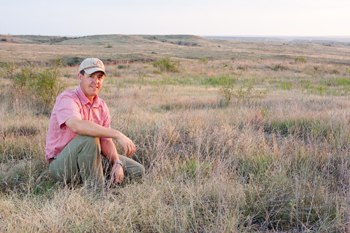
On the JA Ranch, located in the Texas Panhandle, Andrew Bivins is on a mission to "re-introduce the role of fire into a system that is a fire community." A fifth generation rancher, Bivins refers back to photos of his family's property in the late 1800's and early 1900's and notes the distinct lack of brush. "Brush encroachment started in the 20th century when we started suppressing fire." Bivins acknowledges.
Anyone who lives in, or has traveled across, the rolling plains, from Clarendon south to Snyder, and from Silverton east to Throckmorton, can attest to the dominance of mesquite, redberry juniper, and prickly pear.
The use of prescribed fire is slowly gaining acceptance in parts of Texas. The momentum of growth is suppressed by wildfire events, as we suffered through in 2006 and on a much broader scale in 2011. These catastrophic wildfires result in a very negative perception of any kind of fire.
It's important to make a distinction between prescribed fire and wildfire. A prescribed fire is a pre-planned, pre-contained fire, intentionally lit under strict weather conditions (temperature, humidity, wind speed) and fuel (vegetation) guidelines to achieve specific objectives that result in targeted rangeland and ecosystem health improvements. Conversely, a wildfire is an uncontained fire accidentally or naturally lit that could burn under terrible conditions (hot, windy, and dry) through any fuel (natural or man-made) in its path and, though it creates some ecological benefits, is predominantly destructive and unwelcomed. The wildfires in which we see the greatest destruction occurs under weather conditions that no prescribed fire manager would ever consider working under. When it comes to media coverage, we never hear of a prescribed fire that went well, but we always hear about out of control wildfires started by arcing power-lines. This trend naturally leads to a fear of all fire - period.
While many ranchers acknowledge the role fire plays in the grassland system, it's this fear, this "playing with fire" concept, which prevents this important piece of the prairie ecosystem from achieving its role. Combating this fear are the numerous Prescribed Burn Associations developing across the state. These associations aim to educate and train landowners to increase the use of prescribed fire as a range management tool, and they are progressing.
Bivins is one of the leaders of the Panhandle Prescribed Burn Association, and he also hopes to educate landowners on the benefits of prescribed fire in addition to the act of burning. "I like the economics" says Bivins. In a land of mesquite and redberry juniper (both vigorous root sprouters), turning the land back to grass dominated can be cost prohibitive. While he acknowledges that proper mechanical control gives best results in percent kill of these species (80% - 90%), it's also the most costly technique ($40 - $100/ac). Help from Farm Bill programs can offset at least half of this cost. Yet once completed, mesquite and juniper will return, but can be effectively kept at bay at minimal cost with careful grazing and a rotational prescribed fire regime of every 8 to 10 years. Bivins has also tried chemical control, which can result in decent control of around 50-60% kill on mesquite at around $28 - $30/ac.
Prescribed fire costs Bivins around $8 - $11/ac once deferment of grazing is figured in, which allows fuel to build up prior to the fire, as well as recovery time after the fire. The beauty is the additional benefits brought about by the fire that are not produced with mechanical or chemical. Fire not only sets back troublesome brush, it also stimulates an abundance of plant species important to wildlife (forbs) and refreshes grasses to a more productive state. This flush in vegetative growth improves habitat for species from grasshopper sparrows to kangaroo rats, and horned lizards to mule deer.
To find out more about Prescribed Fire Associations, Bivins recommends that readers check out the website of the Prescribed Burning Alliance of Texas (PBAT) at http://pbatexas.org/. PBAT is striving to increase the use of this important habitat management tool throughout Texas and represents many of the states Burning Associations.
Jeff is Technical Guidance Biologist, TPWD Wildlife District 2 working from Pampa
The Edwards Plateau - A Fire Shaped Land
By Bill Armstrong
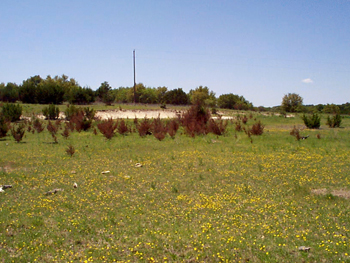
That changed between 10 to 30 million years ago when an upheaval in the earth's crust thrust the Edwards over 2000 feet above sea level. Erosion began to establish the river systems we see today. These rivers generally run from the northwest to the southeast into the Gulf of Mexico. The north and western portions of the area are generally flatter with less topographic relief than the southern areas along the Balcones Fault. The Southern area is called the "Hill Country" because of its highly eroded relief.
For most of its terrestrial history, the Edward's plants and animals were influenced by the earth's ice age climate. Scientists have found pollen in caves dating back 15 thousand years. They tell a story of the Hill Country where spruce and cedar forests once dominated. The earth was still under the influence of the ice age at this time. Men were just beginning to explore North America. Fires were probably relatively infrequent during this period. There were a group of plants and animals that were adapted to these forests. This was about to change.
About 12,000 years ago, the ice age began to loosen its grip. The climate began to warm. Wild fires became more frequent. Pollen counts tell use that forests began to give way to shrublands over the next couple of thousand years. Native Americans added to the fire frequency by intentionally and unintentionally setting fires both to attract game to newly growing vegetation and cooking and warming their shelters with open pit fires. There were a group of plants and animals that became adapted to the shrubland conditions.
Pollen counts also tell us that as time progressed the shrub pollen began to be replaced by more grassland pollen. Fires became even more frequent. There were a group of plants and animals that became adapted to these grassland conditions.
By the time of European settlement, much of the Edwards was a grassland with scattered pockets of shrubs and "forested" areas of cedar. In 1840, the German geologist Roemer visited the Hill Country of Texas and recorded his jouneys throughout the Edwards Plateau. He described dense cedar forests along the Balcones Escapment that gave way to open grassland as he headed north from San Antonio along Cibilo Creek. He also described several wild fires he encountered along the route he made to San Saba before returning to his base settlement at New Braunfels.
Europen settlement in the 1880's brought large numbers of cows, sheep and goats. Fires were looked on as natural disasters and were actively controlled. The grasslands were over grazed to the point that grasses could no longer easily carry fire. As a result the land returned to shrubland but with a twist. Excessive numbers of domestic livestock consumed the more palatable shrub species, leaving only the less desirable plants to dominate the land. By the 1940's the Edward's was dominated by ashe juniper (cedar) and liveoak. Ranchers actively began expensive, labor intensive, and time-consuming programs to mechanically reduce this "invasion" of brush only to see a new invasion of brush species.
By the 1970's, it was becoming evident that a better method of controlling ashe juniper was necessary. Scientist at both the Kerr Wildlife Management Area and the Sonora Experiment Station began working with prescribed fire (intentionally set fires). The Sonora Experiment Station studied the effects of summer burns on vegetation, while the Kerr Wildlife Management Area studied the effects of cool season burns. There were reasons why these two paths were taken; but first we need a basic understanding of fire and prescribed burns and how plants grow.
Basic fire behavior
Prior to 1970, fire had been used for many years in the eastern United States as a forest management tool. Over time, some basics had been learned about prescribed fire. It was felt that fire was too dangerous to be used outside of the eastern half of the US.
Fire is a combination of three factors – heat, oxygen and fuel. By controlling inputs of any of these factors you can control fire behavior. For instance, most people who want to put out a fire, pour water on the fire. The moisture absorbs the heat and denies the fire oxygen. The fire goes out. In nature, the amount of moisture in the air (humidity) can dramatically effect fire behavior. High humidity means slow moving easily controlled fires. Low humidity means faster ignition and "hotter" fires.
If you have ever tried to build a campfire and the fire just would not burn, you probably blew on the fire and the flames got bigger. You pumped oxygen into the fire making the burning process easier. In nature, wind does the same thing. The greater the wind, the more oxygen is pumped into the fire.
These two factors, wind speed and humidity are the two greatest factors in nature that control fire behavior. If a fire is ignited on a day with high humidity and low wind speeds, it will be a gentle slow moving fire that can be easily controlled. If the same area is burned on a day with low humidity and high wind speeds, the fire will be intense and difficult to control. By selecting only those days with favorable weather patterns for a burn, fire behavior can be safely predicted.
Other factors which influence the fire would be fuels, their continuity, and volatility. In the Edwards plateau, grass is the primary fuel and the transporter of fire from one point to the next. Green grass is 70% water and relatively difficult to burn. Dead grass is more volatile; however, it absorbs moisture from the air (humidity) and can vary greatly in moisture content. Rainfall amounts and livestock grazing numbers will predetermine the amount and uniformity of fuel available to burn.
Basic Plant Facts
There are three broad categories of plants – Forbs, Browse, and Grass. When a plant is growing it generally has high moisture content - as much as 70% of a growing plant can be water. When plants are dormant, much of their energy reserves are stored below ground level. When they are growing, a great deal of energy is above ground level. If you burn when a plant is growing, you can significantly reduce its energy reserves making it easier to kill.
Grasses grow from ground level. The growing tip for woody plants is at the tip end of the stem. If you burn when plants are growing you can more easily kill the growing tip of woody plants as compared to grass. Many forbs must come up yearly from seed (annuals). Other forbs will store their energy in the root systems below ground level. Summer burns usually get a better kill on woody plants and tend to select for grasslands mixed with forbs.
Some plants have thick bark to protect them from fire. Examples of these plants would be most oaks and hickories. These plants will better survive both summer and winter fires. Some plants have thin bark and are easily top killed by fire. Examples of these plants would be junipers (Cedars), bumelias, redbuds, and sumacs. These plants rely on seed germination for survival. However, if burned during dormant winter periods, they can rapidly recover from the fire effects because of their stored root reserves.
Ashe juniper (cedar) is a non-fire tolerant plant. Plants less than 4 feet tall can easily be killed with just 6 seconds of exposure to fire. A gentle, slow moving fire can readily kill small juniper. Prior to European settlement juniper was restricted to those areas that did not burn frequently such as overgrazed areas along rivers and streams, areas of shallow soils with little grass production and areas where rough topography stopped fire. Reinvasion from cedar can be fairly rapid. Usually within 4 to 7 years. Fires therefore had to be frequent if cedar was a minor component of the historical vegetation.
Back to fire - summer burns, winter burns and prescriptions.
Whenever you burn under a predetermined set of environmental conditions to achieve a predetermined objective you have conducted a prescribed burn.
If you want to return an area back to a grassland state with little woody plants in the mix, then intense fires during the growing season is your best option. Late summer burns were more common prior to European settlement. These fires favored the buffalo, antelope, prairie chickens, and other grassland animals. You can design less intense summer burns without as much harm to woody species.
If you wish to have more woody plants available for wildlife, then less intense cool season burns may be more desirable. Cool season burns would favor shrub land animals and birds such as white-tailed deer and black-capped vireos. You can, however, design intense cool season burns that will top kill many plants.
Scientists, through many years of observing the effects of different fire intensities, frequency of fires, and timing of fires on vegetation have developed various "fire prescriptions" to achieve predictable results. For instance, if your objective is to reduce the amount of regrowth juniper on your land without harming overstory woody plants, then burn with a 30% humidity, a wind speed of less than 10 mph, and about 1200 pounds of grass per acre. This prescription will kill about 80% of the juniper less than 4 feet tall without harming overstory plant species.
Over the years, standards, laws, and rules for conducting prescribed burns have been developed. These laws deal with training and environmental concerns. The Texas Department of Agriculture has been assigned the primary responsibility for the certification and training of prescribed burn personal. You can also contact your local NRCS, TPWD or Texas AgriLife Agent to find training opportunities in your area.
Bill Armstrong is a retired TPWD Wildlife Biologist having spent most of his career on Kerr WMA. Bill along with other colleagues on Kerr WMA pioneered efforts to better understand the effects of a variety of tools on the landscape and initiated some of the first efforts to address wildlife habitat needs from and ecological perspective
From the Back Porch
By Mark Klym
That was my introduction to the Bastrop Complex fire. The year 2011 was dotted with wildfires across Texas - Union Chapel, Tri Counties, Block House, Oasis Pipeline, Possum Kingdom - the names are seared into our memory and the images provided by the media are branded in history. A constant barrage of pictures, stories, and firsthand accounts kept us informed to the point many simply tuned it out.
For a person who grew up with Smokey Bear telling us that fire was a thing to be prevented, the thought of a fast moving wildfire two miles from the front door of my home was terrifying. We have grown up in an age where every hint of smoke is answered by wailing sirens and teams of fighters to get it under control. And well they should with wildfire.
Fire does not have to be destructive though. Removing the fuel load in front of a fire by lighting a back fire is one of the best tools to stop a rapidly moving fire. Why not remove the fuel before hand – a prescribed fire, like some of our writers discuss in their articles, not only removes the fuel but, depending on the prescription, will help create or maintain the habitat for wildlife you want on your land.
They did this in Bastrop State Park. For several years before the Bastrop Complex fire, they had burned selected tracts on a rotating basis. Interestingly, the areas that had most recently received a prescribed fire showed little impact from the wildfire, while areas they had not had a chance to burn had major damage.
I have had the pleasure in 2012 of walking some of the land that burned in the Block House fire. If I had not known of the fire, I would have had to be convinced that the area had burned as recently as 2011. Grass and forbs are "greening up." The one thing that is "missing" from the "before picture" is the widespread brush.
In Bastrop, the story is a little more delayed. In a forest setting, it takes much longer for the plant community to recover, but there is green showing. Some even report small pines on their property – which makes sense since some plants require fire for their seed to germinate!
Fire! It does not have to be a frightening experience. Sometimes, when used with the proper prescription, it can help prevent major disasters.
Mark is an information specialist with the Wildlife Diversity Program working out of Austin

 Texas Parks and Wildlife Department, 4200 Smith School Road, Austin, TX 78744
Texas Parks and Wildlife Department, 4200 Smith School Road, Austin, TX 78744


